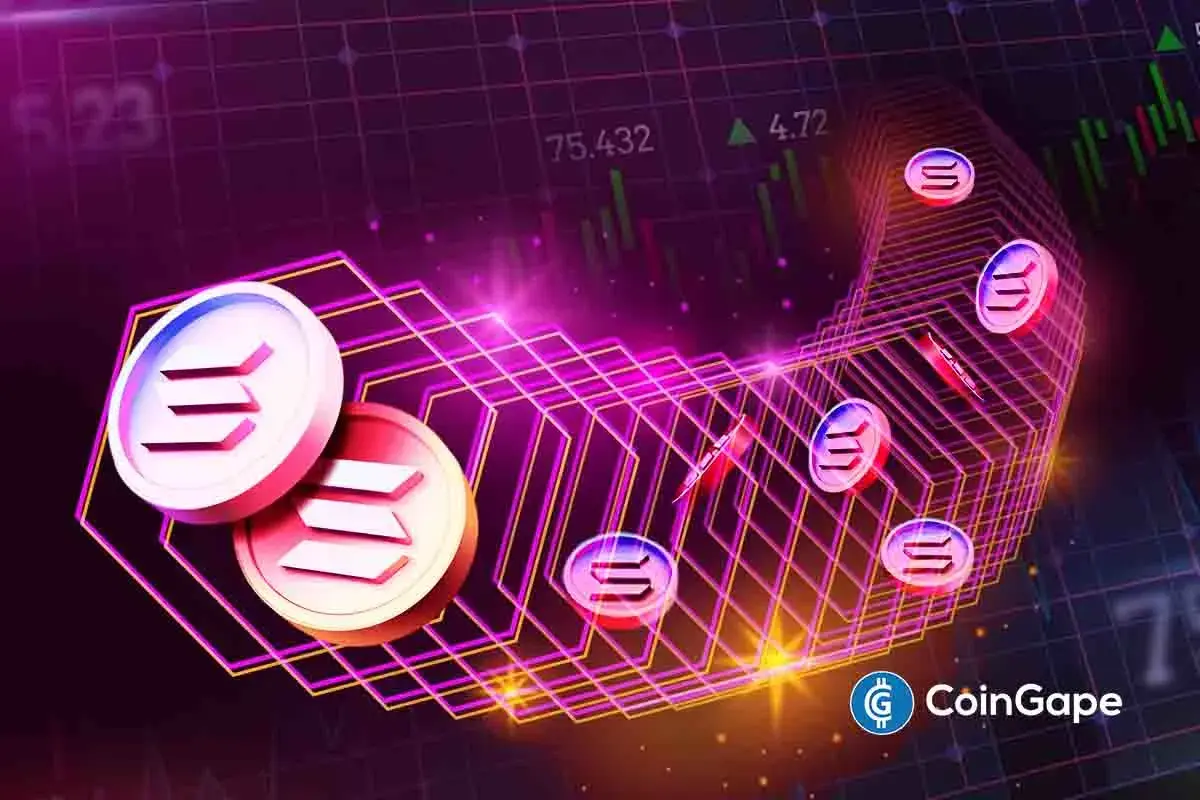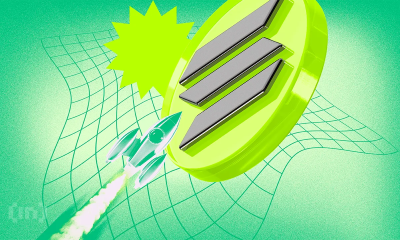Market
Latam Crypto News: Brazil Approves Solana ETF

BeInCrypto comprehensive Latam Crypto Roundup brings Latin America’s most important news and trends. With reporters in Brazil, Mexico, Argentina, and more, we cover the latest updates and insights from the region’s crypto scene.
This week’s roundup includes stories on Solana ETF approval in Brazil, Bolivia’s interest in metal-backed stablecoins, and more.
Brazil Approves World’s First Spot Solana-Based ETF
The Brazilian Securities and Exchange Commission (CVM) has given the green light for the launch of the world’s first spot Solana-based exchange-traded fund (ETF). This product is currently in its pre-operational phase, with final approval pending from Brazil’s main stock exchange, B3.
The spot Solana ETF, managed by QR Asset and operated by Vortx, will track the CME CF Solana Dollar Reference Rate. Theodoro Fleury, Chief Investment Officer of QR Asset, expressed enthusiasm about the new ETF.
“This ETF reaffirms our commitment to offering quality and diversification to Brazilian investors. We are proud to be global pioneers in this segment, consolidating Brazil’s position as a leading market for regulated investments in crypto assets,” Fleury said.
Read more: Solana ETF Explained: What It Is and How It Works
The ETF launch will integrate Solana into mainstream financial systems and mark the first Solana-based product in Brazil. Over the past few years, the Latam country has shown a strong interest in pioneering financial products, with B3 playing a major role.
The exchange has listed several crypto ETFs, including those for Bitcoin and Ethereum, between 2021 and 2022. Most recently, in March 2024, B3 began offering BlackRock’s iShares Bitcoin Trust (IBIT).
Peru Launches New Anti-Money Laundering Regulation for Crypto Companies
Starting August 1, Peru’s cryptocurrency market enters a new regulatory era. The Superintendency of Banking, Insurance, and AFPs (SBS) has introduced the country’s first official framework aimed at preventing money laundering and terrorist financing within the sector.
This regulation requires all cryptocurrency businesses, including digital wallet providers and investment platforms, to follow strict anti-money laundering (AML) measures. The SBS will oversee these entities to ensure they implement a “risk-based approach” to deter illicit activities.
A key aspect of the new rules involves verifying the identity of transaction beneficiaries. This step aims to prevent corrupt funds and other illicit gains from infiltrating the financial system. The regulation covers all transactions, even those under $1,000, with potential for increased scrutiny in the future.
Read more: Crypto Regulation: What Are the Benefits and Drawbacks?
Non-compliance with these regulations could result in severe penalties. Companies that fail to meet the new standards may face hefty fines, the loss of their operating licenses, or the removal of their websites and apps.
This measure aligns with Recommendation 15 of the Financial Action Task Force (FATF), which urges countries to enforce legal frameworks for the supervision of virtual asset service providers (VASPs). Peru’s move follows similar actions in other Latam countries, such as Argentina, where stricter crypto regulations were implemented despite initial resistance.
Paraguay Dismisses Exodus of Miners Despite Higher Electricity Rates
Paraguay’s National Electricity Administration (ANDE) has dismissed concerns over an exodus of cryptocurrency mining companies following a hike in electricity rates. The increase, which raised tariffs by up to 16% for large-scale cryptocurrency miners, sparked fears of companies fleeing to neighboring countries like Brazil.
The Paraguayan Chamber of Mining of Digital Assets (Capamad) had previously warned that many cryptocurrency miners were considering relocating to Brazil due to the rising costs. Capamad suggested that Paraguay could lose its appeal as a favorable location for Bitcoin mining.
However, Félix Sosa, president of ANDE, refuted these claims, asserting that no mining companies had left Paraguay. Sosa highlighted a recent contract with a large mining operation, which secured the supply of 6 megawatts (MW) of electricity, ensuring the continued operation of 72 mining companies in the country.
“A technical evaluation is made to verify where to install, where ANDE has power availability for the installation of this type of load,” Felix Sosa explained to ABC.
Read more: Is Crypto Mining Profitable in 2024?
Sosa also revealed that these 72 companies currently have 391 MW of contracted electricity, with a total potential of 821 MW. He shared that ANDE expects to generate $100 million in revenue from these contracts. Additionally, 400 MW of new contracts with mining companies are pending approval.
In contrast, Jimmy Kim, director of Capamad, noted that the expansion plans of many cryptocurrency mining companies now favor Brazil over Paraguay. He pointed to a contract signed by Penguin Group for 400 MW in Brazil, with another 400 MW in the pipeline.
Despite these tensions, ANDE has maintained its stance, arguing that the increased tariffs will help reduce losses from illegal mining activities, which amount to over $185,000 annually. The tariff increase, outlined in Resolution 49238 issued on June 26, targets large-scale cryptocurrency miners specifically.
Bolivian President Luis Arce is advocating for the adoption of cryptocurrencies backed by metals, such as lithium and gold, as part of a broader strategy to strengthen Bolivia’s financial system. This move aims to integrate digital assets with the country’s abundant mineral resources while reducing reliance on the US dollar.
President Arce highlighted that this initiative would promote the use of metal-backed cryptocurrencies like Tether’s Alloy stablecoin (aUSDT). He noted that the measure is designed to streamline the flow of foreign currency into Bolivia and strengthen the payment system for international transactions.
“The greater dissemination of cryptoassets backed by gold, lithium, and other technological metals like Alloy (aUSDT) will boost the inflow of foreign currency into the country and deepen the payment system for international purchases,” Arce stated.
Read more: A Guide to the Best Stablecoins in 2024

This push follows a recent proposal by Congresswoman Mariela Baldivieso, who introduced a bill in the Bolivian Legislative Assembly to regulate Bitcoin. Baldivieso argued that cryptocurrencies could enable Bolivia to conduct transactions and receive international payments without depending on traditional fiat currencies.
In June, Bolivia lifted its ban on cryptocurrencies, allowing the use of “virtual assets” through Electronic Payment Instruments (EPI). The announcement by Edwin Rojas, president of the Central Bank of Bolivia, marked a shift in the country’s financial policies.
Uruguay Sees Rising Interest in Real Estate Deals Using Bitcoin
Uruguay is witnessing a rising trend in real estate transactions conducted with Bitcoin, signaling a shift in how properties are bought and sold. Recently, a property was purchased for $500,000 in Bitcoin, facilitated by Banque Heritage as an intermediary.
This event is showcasing Bitcoin’s potential as a medium of exchange in real estate. Cryptocurrencies, known for challenging traditional financial systems, offer an alternative to conventional currencies by enabling quick, borderless transfers without the need for banks or other intermediaries.
Local analysts highlight several advantages of using Bitcoin for real estate transactions, including faster processes and reduced costs. By cutting out financial intermediaries, transaction fees decrease, and the global market becomes more accessible, free from the complexities of currency conversions.
Read more: How To Invest in Real-World Crypto Assets (RWA)?
Uruguay has quickly embraced the use of cryptocurrencies in real estate. As of October 1, 2022, a new law allows buying and selling property with digital currencies. This change made what was once considered a swap into a fully legal sale, recognizing cryptocurrencies as valid payment.
The General Tax Directorate, which previously didn’t accept cryptocurrencies for real estate transactions, has now welcomed this new approach. This positions Uruguay as a leader in bringing digital assets into the real estate market. On July 17, 2023, this was clearly demonstrated when a property was sold using Bitcoin, with Banque Heritage and Cryptotrust managing the transaction.
Binance VP for Latam to Speak at RIW 2024 on BeInCrypto Stage
As Rio Innovation Week 2024 approaches, Guilherme Nazar, Vice President for Latin America at Binance, has been confirmed as a speaker on the BeInCrypto stage. Nazar will address the current state of the industry, future prospects, and the path to reaching the next billion users.
Nazar will also discuss the importance of customer focus, education, and security in advancing crypto adoption, particularly in Latam. He noted that Brazil is heavily investing in Web3 solutions, positioning it as a global leader in this area.
“Latin America is a market with great prospects for the digital asset ecosystem, home to three of the top 20 countries in adoption, and there are endless opportunities to develop the local industry, meet users’ needs and educate society. We are determined to work hand in hand with policymakers to define regulations that allow innovation to advance and protect users’ funds,” he said on taking over management of the region.
Read more: A Calendar of the Top Blockchain and Cryptocurrency Events in 2024
Alena Afanaseva, CEO of BeInCrypto, and Fabrício Tota, Director of New Business at Mercado Bitcoin, will join Nazar on stage. Afanaseva has turned BeInCrypto into a global crypto news hub with eight million monthly visitors. Tota, meanwhile, is a key figure in Brazil’s crypto industry.
The BeInCrypto stage at Rio Innovation Week will feature names like Agrotoken, B3, and Comissão de Valores Mobiliários (CVM). Other participants include Itaú Unibanco, Bradesco, BTG Pactual, Banco do Brasil, and Microsoft. TecBan, ABCripto, Bitso, Trexx, MIBR, Plataforma Impact, and the Ethereum Brasil community will also be present.
As the Latam crypto scene grows, these stories highlight the region’s increasing influence in the global market. Stay tuned for more updates and insights in next week’s roundup.
Disclaimer
In adherence to the Trust Project guidelines, BeInCrypto is committed to unbiased, transparent reporting. This news article aims to provide accurate, timely information. However, readers are advised to verify facts independently and consult with a professional before making any decisions based on this content. Please note that our Terms and Conditions, Privacy Policy, and Disclaimers have been updated.
Market
Report Alleges Massive Meme Coin Sniping on Pump.fun

According to a new report from Pine Analytics, token deployers on Pump.fun systematically funded sniper wallets to buy their own meme coins. This impacted over 15,000 token launches on the platform.
These sniper wallets operated primarily during US trading hours, executing standardized, profitable strategies. Unrelated bot activity obscures their behavior, making it extremely difficult to isolate these wallets—and they can readily adapt to new countermeasures.
Snipers Roam Free on Pump.fun Meme Coins
Pump.fun has remained one of the most popular meme coin launchpads on Solana despite persistent controversies and other criticism.
However, Pine Analytics’ new report has uncovered a new controversy, discovering systematic market manipulation on the platform. These snipes include as much as 1.75% of all launch activity on Pump.fun.
“Our analysis reveals that this tactic is not rare or fringe — over the past month alone, more than 15,000 SOL in realized profit was extracted through this method, across 15,000+ launches involving 4,600+ sniper wallets and 10,400+ deployers. These wallets demonstrate unusually high success rates (87% of snipes were profitable), clean exits, and structured operational patterns,” it claimed.
Solana meme coin deployers on Pump.fun follow a consistent pattern. They fund one or more sniper wallets and grant them advance notice of upcoming token launches.
Those wallets purchase tokens in the very first block and then liquidate almost immediately—85% within five minutes and 90% in just one or two swap events.

Pump.fun meme coin developers exploit this tactic to create the appearance of immediate demand for their tokens. Retail investors, unaware of the prior sell‑off, often purchase these tokens after the snipe, giving developers an unfair advantage. This constitutes market manipulation and erodes trust in the platform.
Pine Analytics had to carefully calibrate its methods to identify genuine snipers. Apparently, 50% of meme coin launches on Pump.fun involve sniping, but most of this is probably bots using the “spray and pray” method.
However, by filtering out snipers with no direct links to developer wallets, the firm missed projects that covered their tracks through proxies and burners.
In other words, the meme coin community does not have adequate defenses against systematic abuse on Pump.fun. There are a few possible ways that the platform could flag repeat offenders and sketchy projects, but adaptive countermeasures could defeat them. This problem demands persistent and proactive action.
Unfortunately, it may be difficult to enact such policies. Meme coin sniping is so systematic that Pump.fun could only fight it with real commitment.
Analysts think that building an on-chain culture that rewards transparency over extraction is the best long-term solution. A shift like that would be truly seismic, and the meme coin sector might not survive it.
Disclaimer
In adherence to the Trust Project guidelines, BeInCrypto is committed to unbiased, transparent reporting. This news article aims to provide accurate, timely information. However, readers are advised to verify facts independently and consult with a professional before making any decisions based on this content. Please note that our Terms and Conditions, Privacy Policy, and Disclaimers have been updated.
Market
Solana Leads Blockchain Metrics as SOL Momentum Builds

Solana (SOL) continues to show strength across multiple fronts, maintaining a bullish structure on its Ichimoku Cloud chart while gaining momentum in key market metrics. The BBTrend indicator has turned higher again, signaling renewed buying pressure after a brief cooldown.
On-chain activity remains strong, with Solana leading all blockchains in DEX volume and dominating fee generation thanks to the explosive growth of meme coins and launchpad activity. With SOL now trading above a key resistance level, the path is open for further upside—though a loss of momentum could still trigger a retest of lower supports.
Solana Maintains Bullish Structure, but Momentum Faces Key Test
On Solana’s Ichimoku Cloud chart, the price is currently above the Kijun-sen (red base line) but has dipped below the Tenkan-sen (blue conversion line), signaling weakening short-term momentum.
The flattening Tenkan-sen and price behavior suggest possible consolidation or the early stages of a pullback. Still, with the price holding above the Kijun-sen, medium-term support remains intact.
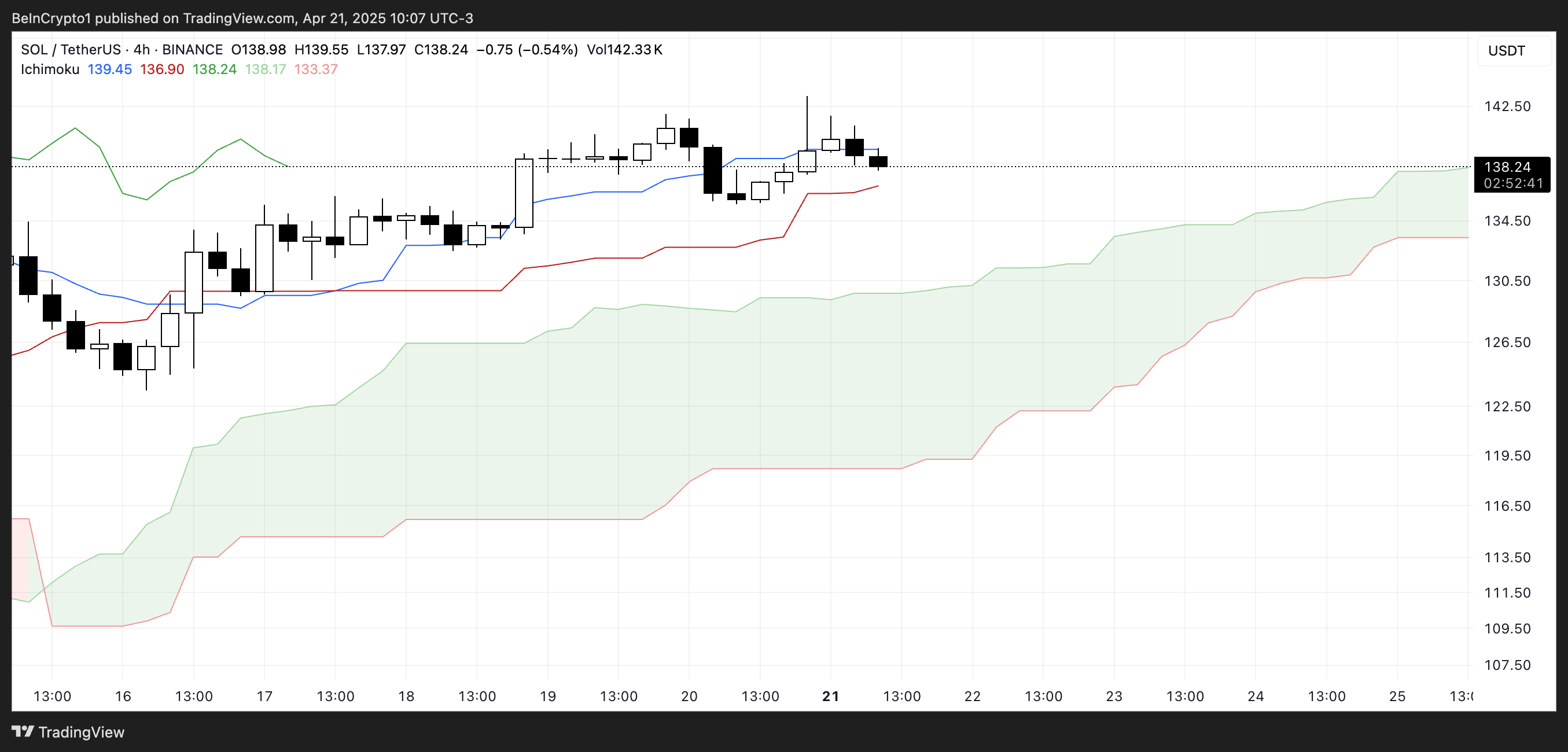
The overall Ichimoku structure remains bullish, with a thick, rising cloud and leading span A well above span B—indicating strong underlying support.
If Solana finds support at the Kijun-sen and climbs back above the Tenkan-sen, the uptrend could regain strength; otherwise, a test of the cloud’s upper boundary may follow.

Meanwhile, Solana’s BBTrend is currently at 6, extending nearly ten days in positive territory after peaking at 17.5 on April 14. The recent increase from 4.26 to 6 suggests renewed bullish momentum following a brief cooldown.
BBTrend, or Bollinger Band Trend, tracks the strength of price movement based on Bollinger Band expansion.
Positive values like the current one point to an active uptrend, and if the BBTrend continues to rise, it could signal stronger momentum and potential for another upward move.
Solana Dominates DEX Volume and Fee Generation as Meme Coins Drive Ecosystem Growth
Solana has once again claimed the top spot among all chains in DEX volume, recording $15.15 billion over the past seven days. The combined total of Ethereum, BNB, Base, and Arbitrum reached $22.7 billion.

In the last 24 hours alone, Solana saw $1.67 billion in volume, largely fueled by its booming meme coin ecosystem and the ongoing launchpad battle between PumpFun and Raydium. Adding to this good momentum, Solana recently surpassed Ethereum in Staking Market Cap.

When it comes to application fees, Solana’s momentum is just as clear. Four of the top ten fee-generating apps over the past week—PumpFun, Jupiter, Jito, and Meteora—are Solana-focused.
Pump leads the pack with nearly $18 million in fees alone.
Solana Breaks Key Resistance as Uptrend Targets Higher Levels, but Risks Remain
Solana has finally broken above its key resistance at $136, flipping it into a new support level that was successfully tested just yesterday.
Its EMA lines remain aligned in a bullish setup, suggesting the uptrend is still intact.
If this momentum continues, SOL price could aim for the next resistance zones at $147 and $152—levels that, if breached, open the door to a potential move toward $179.
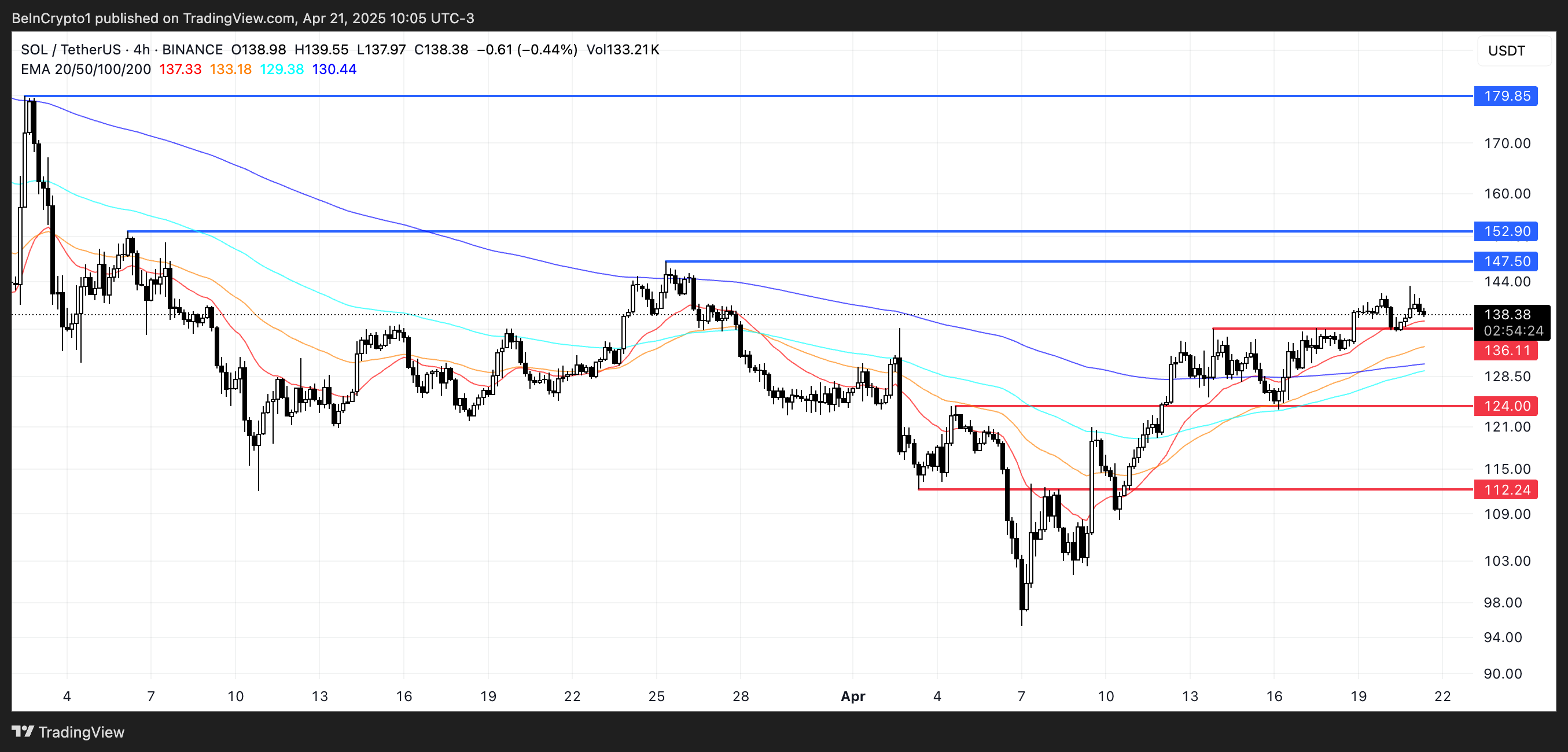
The current structure favors buyers, with higher lows and strong support reinforcing the trend.
However, if momentum fades, a retest of the $136 support is likely.
A breakdown below that level could shift sentiment, exposing Solana to deeper pullbacks toward $124 and even $112.
Disclaimer
In line with the Trust Project guidelines, this price analysis article is for informational purposes only and should not be considered financial or investment advice. BeInCrypto is committed to accurate, unbiased reporting, but market conditions are subject to change without notice. Always conduct your own research and consult with a professional before making any financial decisions. Please note that our Terms and Conditions, Privacy Policy, and Disclaimers have been updated.
Market
Crypto Firms Donated $85 million in Trump’s Inauguration
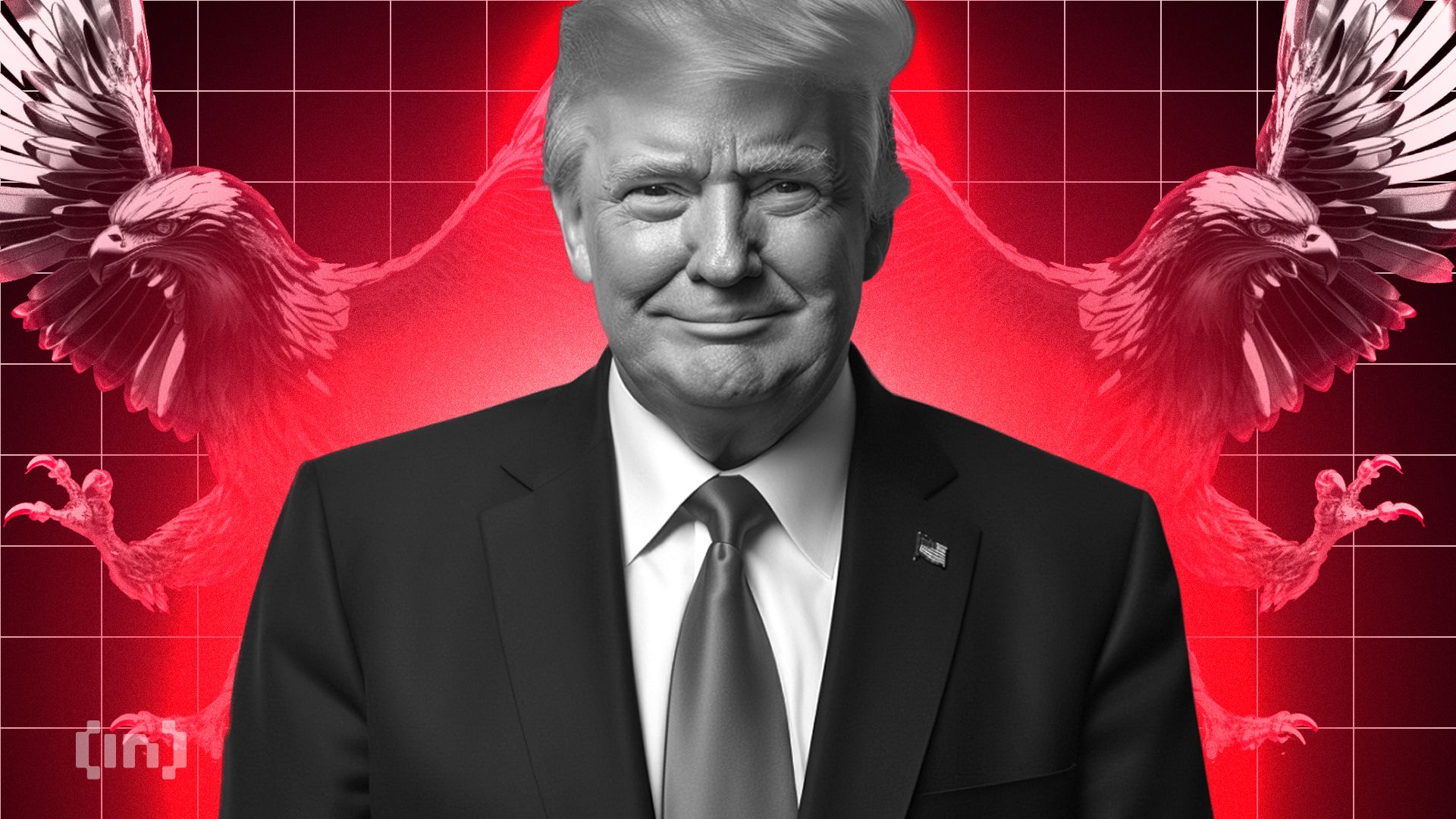
According to a new report, 15 firms and individuals from the crypto industry donated more than $100,000 to President Trump’s Inauguration, totaling over $85 million.
Almost all of these companies apparently received direct or indirect benefits from Trump’s administration. This includes dropped legal proceedings, lucrative business partnerships, participation in Trump’s Crypto Summit, and more.
Crypto Industry Went All-In on Trump’s Inauguration
Since promising to bring friendlier regulations on the campaign trail, Donald Trump attracted a reputation as the Crypto President.
Trump’s Inauguration festivities included a “Crypto Ball,” and several prominent firms made donations for these events. Today, a report has compiled all crypto-related contributions of over $100,000, revealing some interesting facts.

Since taking office, President Trump and his family have been allegedly involved in prominent crypto controversies, and these donations may be linked to several of them.
For example, eight of the donors, Coinbase, Crypto.com, Uniswap, Yuga Labs, Kraken, Ripple, Robinhood, and Consensys, had SEC investigations or lawsuits against them closed since Trump’s term began.
The commission might have dropped its probe against these companies anyway due to its changing stance on crypto enforcement. However, being in the President’s good books likely helped the process.
Further Alleged Benefits for Donors
In other words, nearly half the firms that made donations to Trump’s Inauguration have seen their legal problems cleared up quickly. This isn’t the only regulation-related benefit they allegedly received.
Circle, for example, recently made an IPO after openly stating that Trump’s Presidency made it possible. Galaxy Digital received SEC approval for a major reorganization, a key step for a NASDAQ listing.
Other donors, such as Crypto.com and ONDO, got more direct financial partnerships with businesses associated with the Trump family.
Previously, Ripple’s CEO, Brad Garlinghouse, anticipated a crypto bull market under Trump. Also, XRP, Solana, and Cardano were all unexpectedly included in the US Crypto Reserve announcement.
All three of these companies made major donations to Trump’s Inauguration.
It seems that most of the firms involved got at least some sort of noticeable benefit from these donations. Donors like Multicoin and Paradigm received invitations to Trump’s Crypto Summit, while much more prominent groups like the Ethereum Foundation got snubbed.
Meanwhile, various industry KOLs and community members have already alleged major corruption in Trump’s crypto connections.
While some allegations might lack substantial proof, the crypto space has changed dramatically under the new administration, for both good and bad.
Disclaimer
In adherence to the Trust Project guidelines, BeInCrypto is committed to unbiased, transparent reporting. This news article aims to provide accurate, timely information. However, readers are advised to verify facts independently and consult with a professional before making any decisions based on this content. Please note that our Terms and Conditions, Privacy Policy, and Disclaimers have been updated.
-

 Altcoin24 hours ago
Altcoin24 hours agoArk Invest Gains First Exposure to Solana With 3iQ ETF Bet
-
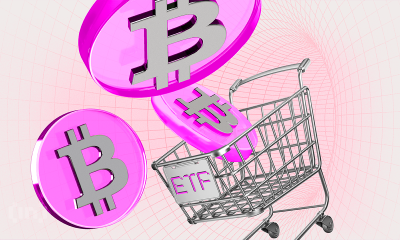
 Market24 hours ago
Market24 hours agoBitcoin ETFs Dominate Market Despite 72 Altcoin Proposals
-

 Market23 hours ago
Market23 hours agoCardano (ADA) Jumps 4% as Bullish Signals Emerge
-

 Altcoin23 hours ago
Altcoin23 hours agoPumpFun Moves $13M SOL To Kraken as Solana Price Consolidates, What Next?
-

 Ethereum21 hours ago
Ethereum21 hours agoEthereum to Emphasize Layer-1 Efficiency and UX in Upcoming Protocol Upgrades
-

 Market22 hours ago
Market22 hours agoXRP Surpasses Ethereum In This Major Metric After Outperforming For 6 Months
-
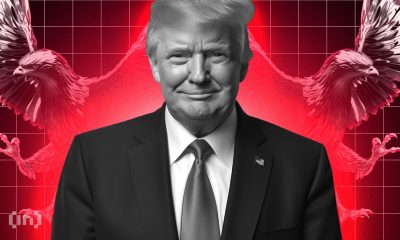
 Market21 hours ago
Market21 hours agoCrypto Firms Donated $85 million in Trump’s Inauguration
-

 Market20 hours ago
Market20 hours agoSolana Leads Blockchain Metrics as SOL Momentum Builds


